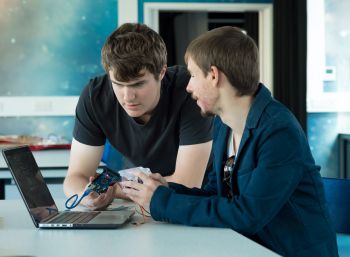Blind Sussex student will describe his 'genius' invention to MPs
By: Tom Furnival-Adams
Last updated: Tuesday, 3 November 2015

David Turner (left) and Daniel Hajas with a module of the TGD model
A blind undergraduate from the University of Sussex will be meeting MPs at the Houses of Parliament to highlight the challenges he and other visually impaired people face in learning science and maths.
Daniel Hajas will be taking part in the British Council for Undergraduate Research’s (BCUR) annual ‘Posters in Parliament’ exhibition in February 2016, which gives UK undergraduates the opportunity to showcase their research to politicians and policy makers.
Unlike the other students at the event, Daniel will be exhibiting a completely blank poster to represent the difficulty that blind students have in accessing vital learning materials.
The third-year Theoretical Physics student will take his audience through a complicated equation, referring to imaginary information on his poster to help them.
Since starting at Sussex, Daniel has been working on ways to help visually impaired learners engage with the charts, graphs and equations that are a staple of science courses.
During his first year he invented a device that translates visual information such as graphs into a tactile format.
He is now working on developing the concept of his ‘Tactile Graphics Display’ (TGD) with help from a scheme that encourages undergraduate research at the University and the assistance of second-year physics student David Turner.
The Junior Research Associate (JRA) scheme, set up by the University of Sussex in 2008, provides talented and ambitious undergraduates with a £2,000 bursary, allowing them to participate in original research with academics over their summer vacation.
Daniel was awarded second prize at a ceremony in October on campus to celebrate the work of this year’s undergraduate researchers.
He was subsequently chosen to represent the University at the BCUR’s annual exhibition at Westminster, together with the JRA scheme’s overall winner Alexandra Earl, whose research examined the extent to which fathers treat their children as individuals with their own personalities.
Daniel’s invention, the TGD, comprises a board that can be connected to a computer or mobile device, with an array of tactile pixels (taxel) on its surface that can be raised or lowered to provide a tactile representation of graphs, diagrams and other visual information.
The young inventor is aiming to commercialise the technology to make it accessible to as many blind people as possible – in line with his belief that “People with disabilities shouldn’t have to pay more for their education than those without disabilities.”
Daniel says: “My aim is to bridge the gap between the way science is done, and the fact that lots of people don’t have access to this visual information.”
Daniel’s supervisor Dr Kathy Romer adds: “Daniel is a genius. I am in awe of his ability to grasp concepts and to carry out complex mathematical derivations without access to images or handwriting.
“There is no way he could have achieved so much against such difficult odds if he didn’t have an exceptional brain. Daniel’s abilities are astonishing, baffling, humbling and inspiring!”
Daniel has recently entered a student enterprise competition at the University, designed to help develop entrepreneurial skills and ultimately provide three winners with valuable start-up funding.
If he is successful in the StartUp Sussex competition, he could win up to £10,000 towards further developing and marketing his TGD.

